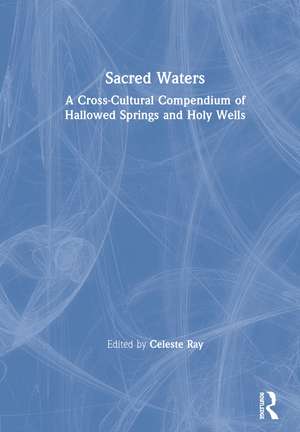Sacred Waters: A Cross-Cultural Compendium of Hallowed Springs and Holy Wells
Editat de Celeste Rayen Limba Engleză Hardback – 3 mar 2020
| Toate formatele și edițiile | Preț | Express |
|---|---|---|
| Paperback (1) | 328.68 lei 43-57 zile | |
| Taylor & Francis – 26 feb 2020 | 328.68 lei 43-57 zile | |
| Hardback (1) | 837.30 lei 43-57 zile | |
| Taylor & Francis – 3 mar 2020 | 837.30 lei 43-57 zile |
Preț: 837.30 lei
Preț vechi: 1112.99 lei
-25% Nou
Puncte Express: 1256
Preț estimativ în valută:
160.27€ • 174.15$ • 134.71£
160.27€ • 174.15$ • 134.71£
Carte tipărită la comandă
Livrare economică 21 aprilie-05 mai
Preluare comenzi: 021 569.72.76
Specificații
ISBN-13: 9780367445126
ISBN-10: 0367445123
Pagini: 416
Ilustrații: 55
Dimensiuni: 174 x 246 x 23 mm
Greutate: 1.42 kg
Ediția:1
Editura: Taylor & Francis
Colecția Routledge
Locul publicării:Oxford, United Kingdom
ISBN-10: 0367445123
Pagini: 416
Ilustrații: 55
Dimensiuni: 174 x 246 x 23 mm
Greutate: 1.42 kg
Ediția:1
Editura: Taylor & Francis
Colecția Routledge
Locul publicării:Oxford, United Kingdom
Public țintă
Postgraduate and UndergraduateCuprins
Holy Wells and Sacred Springs, Celeste Ray; Part 1: Ancient Influences; Chapter 1: Fons et Origo: Observations on Sacred Springs in Classical Antiquity and Traditions, Christopher M. McDonough; Chapter 2: Water Sources and the Sacred in Modern and Ancient Greece, Evy Johanne Håland; Chapter 3: Life and Death from the Watery Underworld: Ancient Maya Interaction with Caves and Cenotes, Nicholas Dunning; Part 2: Stewarding Curative Waters and Caring for Pilgrims; Chapter 4: "Go Drink from the Spring and Wash There": The Healing Waters of Lourdes, Michael Agnew; Chapter 5: The Well of Zamzam: A Pilgrimage Site and Curative Water in Islam, Ahmad Ghabin; Chapter 6: Sacrality, Waterfront Sacred Places in India: Myths and the Making of Place, Rana P.B. Singh; Part 3: Genii Loci and Ancestors; Chapter 7: Freshwater Sources and their Relational Contexts in Indigenous Australia: Views from the Past and Present, Liam Brady; Chapter 8: Inca Shrines: Deities in Stone and Water, Marco Curatola Petrocchi; Chapter 9: Dragon Wells and Sacred Springs in China, Jean DeBernardi, Yan Jie and Ma Junhong; Chapter 10: The Sacred Springs of the Tewa Pueblos, New Mexico, Richard Ford; Part 4: Temporal Powers, Social Identity and Sacred Geography; Chapter 11: Divine waters in Ethiopia: The Source from Heaven and Indigenous Water-Worlds in the Lake Tana Region, Terje Oestigaard and Gedef Abawa Firew; Chapter 12 : Ori Aiye: A Holy Well among the Ondo in Southeastern Yorubaland, Nigeria, Raheem Oluwafunminiyi and Ajisola Omojeje; Chapter 13: Sacred Wells of Banaras: Glorifications, Ritual Practices and Healing, Vera Lazzaretti; Chapter 14: Yaksutŏ: Korean Sacred Mineral Spring Water, Hong-key Yoon; Chapter 15: Sacred Hierarchy, Festival Cycles and Water Veneration at Chalma in Central Mexico, Ramiro Gómez Arzapalo Dorantes; Part 5: Medieval Europe; Chapter 16: Between Fons and Foundation: Managing a French Holy Well in the Miracula Sancti Theoderici, Kate M. Craig; Chapter 17: Finnaun y Doudec Seint: A Holy Spring in Early Medieval Brycheiniog, Wales, Andy Seaman; Chapter 18: Gvendarbrunnur of Medieval Iceland, Margaret Cormack; Part 6: Contested and Shared Sites; Chapter 19: A Higher Level of Immersion: A Contemporary Freshwater Mikvah Pool in Israel, Robert Phillips; Chapter 20: Waters at the Edge: Sacred Springs and Spatiality in Southwest Finnish Village Landscapes, John Björkman; Chapter 21: Memory and Martyrs: Holy Springs in Western Siberia, Jeanmarie Rouhier-Willoughby; Chapter 22: Sacred and Healing Springs in the Republic of Macedonia, Snežana Filipova; Chapter 23: Water Sanctuaries of Hatay, Turkey, Jens Kreinath; Part 7: Sacred Waterfalls; Chapter 24: Sacred Waters of Haitian Vodou: The Pilgrimage of Sodo, Elizabeth McAlister; Chapter 25: The Olympic Mountains and the Sacrality of Water in the Klallam World, Cailín Murray; Chapter 26: Back into the Light: Water and the Indigenous Uncanny in Northeastern Japan, Ellen Schattschneider; Part 8: Popular Pieties; Chapter 27: With Sacred Springs, without Holy Wells: the Case of Estonia, Heiki Valk; Chapter 28: Holy Wells of Wychwood Forest, England, Martin Haigh; Chapter 29: Holy Wells and Trees in Poland as an Element of Local and National Identity, Wojciech Bedyński; Chapter 30: Visiting Holy Wells in Seventeenth-Century Sweden: The Case of St. Ingemo’s Well in Dala, Terese Zachrisson; Chapter 31: The Buddha’s Thumb, Nāga Legends, and Blessings of Health: Sacred Water and Religious Practice in Thailand, Rachelle M. Scott; Part 9: Hydrology, Stewardship and Biocultural Heritage; Chapter 32: At the End of the Field, a Pot of Nemunai is Boiling: A Study of Lithuanian Springs, Vykintas Vaitkevičius; Chapter 33: Hydrogeological Characteristics of Irish Holy Wells, Bruce Misstear, Laurence Gill, Cora McKenna and Ronan Foley; Chapter 34: The Holy Springs of Russia’s Orel Region: Traditions of Place and Environmental Care, Jane Costlow; Chapter 35: Sentient Springs and Sources of Life: Water, Climate Change and World-Making Practices in the Andes, Astrid B. Stensrud; Chapter 36: Cures, Flora and Fauna: Ireland’s Holy Wells as Sites of Biocultural Diversity, Celeste Ray
Notă biografică
Celeste Ray is Professor of Environmental Arts and Humanities at the University of the South, USA. She is the author of The Origins of Ireland’s Holy Wells and Highland Heritage: Scottish Americans in the American South, and the editor of volumes considering ethnicity and historical ecology.
Recenzii
In describing the extraordinary ubiquity of sacred water places around the world, this comprehensive collection simultaneously celebrates the rich cultural and historical diversity in the beliefs and practices through which people engage with them, celebrating water‘s essential role in generating life, health and societal wellbeing. A veritable wellspring of ideas.
Professor Veronica Strang, Institute of Advanced Studies, Durham University
Professor Veronica Strang, Institute of Advanced Studies, Durham University
Descriere
Describing sacred waters and their associated traditions in over thirty countries and across multiple time periods, this book identifies patterns in panhuman hydrolatry. The work combines perspectives from anthropology, religious studies, sociology, geography, archaeology, history and folklore.
